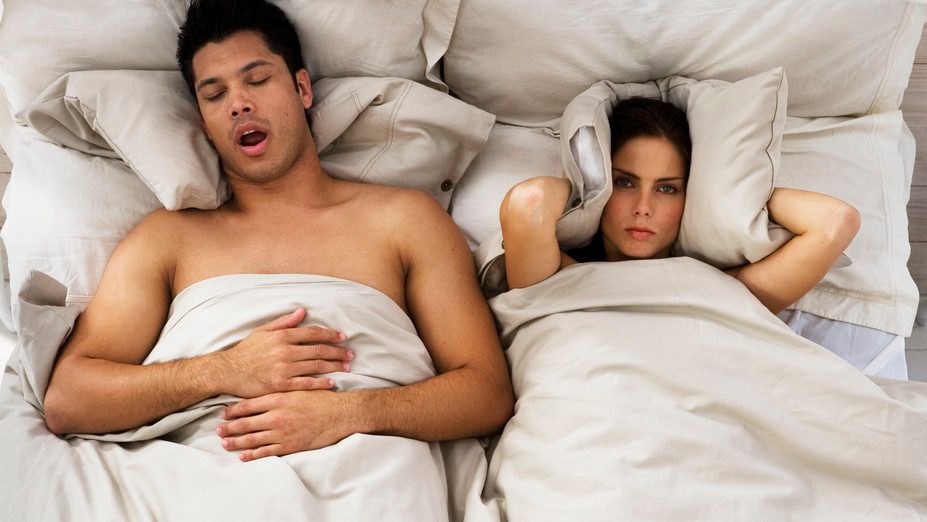Do You Snore? Don’t Ignore that Rattling Sound!

Nearly 25 percent of Americans may suffer from sleep apnea.
Although David Silverman didn’t know he snored, his wife did. When the couple brought their son to an ear, nose and throat (ENT) doctor to check his adenoids, his wife surprised him, saying “Why don’t you check my husband, too?” After a sleep test, the doctor told Silverman he stopped breathing 60 times an hour, when the walls of his throat collapsed — a condition called sleep apnea.
The National Sleep Foundation reports that 11.6 percent of Americans have been diagnosed with sleep apnea, and studies suggest that another 13 percent of the population may suffer undiagnosed.
The tell-tale sign is a loud snore and restless sleep. You may wake up with a dry throat, headache, or feel unrested despite enough hours in bed. You might feel sleepy during the day. Don’t ignore these symptoms. Sleep apnea increases the risk of diabetes, stroke, high blood pressure, heart failure, and car accidents from sleepiness at the wheel. Silverman, a financial executive, had been feeling tired much of the day for years.
The classic patient is a middle-aged overweight man with a rattling snore who struggles with daytime sleepiness, perhaps falling asleep at his desk, during meetings, or even sometimes behind the wheel. Women are less likely to be referred to sleep studies because their sleep disturbances are often more subtle, but they can also feel the effects of daytime fatigue.
You also needn’t be hugely overweight to have sleep apnea. Losing weight often helps, but it’s especially hard to do when you’re fighting fatigue and grabbing sugar to get through the day. “In my practice only one patient ever lost weight to cure his sleep apnea. That is out of hundreds in our five-person office,” says Murray Grossan, MD, an ENT with the Tower Ear, Nose & Throat Clinic at Cedars-Sinai Medical Center in Los Angeles and author of “The Whole Body Approach to Allergy and Sinus Health.”
Only about half of all loud snorers have sleep apnea, but even simple snoring is a sign that may not be getting enough air during the night and could be better-rested.
Another cause of snoring may be allergies or a chronically stuffed nose. If you suffer from allergies, try flushing your nose with salt water at bedtime, using an all-rubber ear syringe, a “Neti-pot,” or an electronic irrigator similar to a water-pik. You can also experiment with over-the-counter decongestants or products that mechanically open your nostrils. These include strips you place on the outside of your nose or tiny plastic cones or boomerang-shaped devices you insert inside the nostrils.
Grossan offers this tip to allergy sufferers who use an electronic irrigator: Add 3 teaspoons of xylitol, a sugar available in the diabetes section of the food market, to saline solution in 500 milliliters of water. The sugar will help cut down bacteria, he says, and allow a swollen nose to heal naturally. It also helps to drink hot tea before getting out of bed in the morning (yes, breakfast in bed), as the transition to cold air after a warm bed can trigger symptoms. Your doctor may be able to identify and treat any nasal obstructions.
Flabby throat muscles, which weaken as we age, are the most common cause of snoring. In a small randomized trial, participants who performed throat-exercises for 20 minutes a day for three months showed improvement in snoring and mild sleep apnea.
British choir director Alise Ojay has created “Singing for Snores,” a CD of guided vocal gymnastics targeted at the most important throat muscles. Grossan recommends a number of low-tech remedies. Try blowing up balloons a few times a day, adopting a wind instrument like the kazoo, humming, or singing vowel sounds at different pitches while holding your tongue up against the back of your teeth. Sing each vowel for at least 3 minutes; the changes in pitch cause variations in vibration that exercise the tissues more completely.
Just plain singing is a good idea, too. “Think of a flabby arm with the flesh hanging down. If you start to exercise, that flabbiness goes away and the arm becomes hard. This is what you’re trying to accomplish,” Grossan says. You’ll need to devote 20 minutes twice a day for at least three months, or as long as it takes.
High-tech solutions involve sleeping with machinery to help you breathe, or, in some cases, surgery. To determine if you have significant sleep apnea, ask your doctor for a prescription for a sleep test, which can be done at home or in a medical facility. You’ll be outfitted with about 20 sensors that are monitored by a technician. Silverman now sleeps with a mask attached to a CPAP (“continuous positive airway pressure”) machine that blows air into his throat. Depending on your sleep test results, you may be fitted with a CPAP machine, or a smaller device customized to fit your jaw.
CPAP machines are highly successful in overcoming sleep apnea, and can help hypertension and gastroesophaeal reflex and cut your appetite, says Grossan.
“You can find hundreds of people who tried CPAP and they tell you it failed. But so much depends on how the doctor handles the patient,” he says. Grossan asks patients to try CPAP for a week and refers them to technicians who help them choose the appropriate machine. “After one week the patient realizes he now feels rested in the AM. Before he felt tired and sleepy; his thinking is much clearer; he has real energy and more sexual energy,” he says.
Surgery is another option, but the results are less effective, he says.
Your best bet is to control your snoring early on. Sing in the shower! It could help you get a better night’s sleep.
Updated:
February 24, 2020
Reviewed By:
Christopher Nystuen, MD, MBA